Bryanna Clark Grogan’s Vegan Feast Kitchen/ 21st Century Table: The kitchen journal of a vegan food writer.. I'm on Facebook and Twitter (see links in sidebar at right).
Monday, November 26, 2007
THERE'S A BIG DIFFERENCE BETWEEN "GLUTEN FLOUR" AND "PURE GLUTEN POWDER" (VITAL WHEAT GLUTEN)!!

UPDATED NOVEMBER 2014:
I had an interesting kitchen disaster yesterday, that I'd like to share with you. While testing recipes for a certain type of seitan, I was making a basic gluten mixture I have made it many times before. But this time it seemed so soft that I added 2 cups more of what I thought was pure gluten powder. When I cooked it, it seemed squishy. When it cooled off, I opened it up and it just fell apart instead of being firm and easy to slice.
I concluded that I was sold the wrong product-- "gluten flour", instead of "pure gluten powder" or "Vital wheat gluten". There is a big difference between the two and if you get the wrong product, your seitan will not be as it should! I was aware of this, but it had never happened to me before. I have purchased my gluten powder in bulk from the same store for many years. But evidently, the last batch I bought was "gluten flour". (I have contacted the store and they are going to contact their supplier.)
 |
| Here is a photo showing the loaves I made yesterday: the one made with gluten flour on the left, and the one made with gluten powder on the right. |
I did a little test with the new batch and the old batch, and found that I was right. I mixed 1 tablespoon of the new batch (the gluten flour) with 1 Tablespoon of water, and did the same with the old batch (the gluten powder). I could immediately see and feel the difference. The gluten flour mixture was more yellow in color and sticky, easy to squish into a thin shape. The gluten powder mixture was grayer in color and rubbery, with a texture that would not easily flatten out. Here are pictures illustrating the difference:
 |
| The one made with gluten flour on the left, and the one made with gluten powder on the right |
 |
| The one made with gluten flour |
 |
| The one made with pure gluten powder (Vital wheat gluten) |
RELIABLE BRANDS OF PURE GLUTEN POWDER:
When I say "reliable", I am quoting other sources. Whenever you are trying a new brand, do the test above.
Nov. 2014 Update: WHAT I USE NOW (CANADIAN SOURCE):
http://www.bulkbarn.ca/en-ca/product/flour/gluten-flour.html (Their product is superior even to Bob's Red Mill brand)
Honeyville Farms Vital Wheat Gluten
Arrowhead Mills Vital Wheat Gluten
Hodgson Mill Vital Wheat Gluten with Vitamin C
Bob's Red Mill Vital Wheat Gluten
NutriMill Vital Wheat Gluten (from Pleasant Hill Grain)
Canning Pantry Vital Wheat Gluten
King Arthur Flour Vital Wheat Gluten
bulkfoods.com Vital Wheat Gluten
Cheers!
Labels:
gluten,
gluten flour,
pure gluten powder,
Vital Wheat Gluten
Tuesday, November 20, 2007
VEGAN THANKSGIVING PHOTOS


Carving the Seitan "Turkey"
See links to lots of holiday recipes here.
Vegan Pumpkin Pie (no tofu in it!), from my book The Almost No-Fat Holiday Cookbook, p. 165.)

Soy and Seitan "Turkey" (recipe for the prototype to this baked version in my book Soyfoods Cooking for a Positive Menopause, p. 132-133.)


Leftover stuffing made into patties and served with cranberry sauce and gravy. (My stuffing recipe [p. 103], cranberry sauce recipe [ p. 106], and Mushroom Gravy [p. 101] recipes are in my book The Almost No-Fat Holiday Cookbook; My Rich Brown Yeast Gravy recipe (a template for many variations) recipe is in my books Soyfoods Cooking for a Positive Menopause, 20 Minutes to Dinner, The Almost No-fat Cookbook, and World Vegan Feast.
Our favorite Tofu Pot Pie (recipe from my book Soyfoods Cooking for a Positive Menopause) pictured at the middle right of this picture:
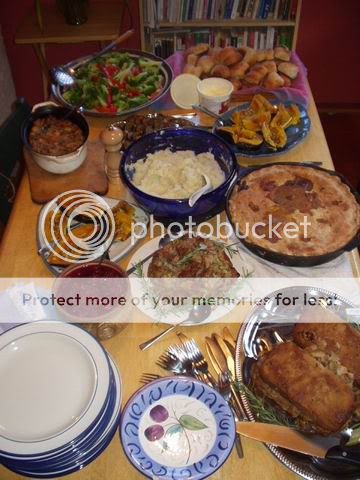
Our Thanksgiving feast, Oct.'04; photo by Fireweed
SOME THANKSGIVING BLOG ENTRIES:
This year's Canadian Thanksgiving, with a recipe for Ginger Apple Crumb Pie with Creamy Cashew-Pear Dessert Sauce.

A recipe for Maple-Walnut Sheaf of Wheat Bread:

And these vegan Pumpkin-Pecan Cupcakes with Lemon "Buttercream" would make a good Thanksgiving weekend treat!
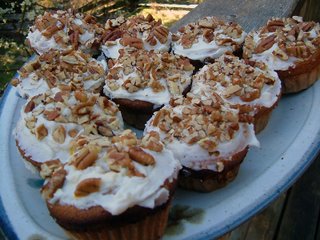
Happy Thanksgiving!

Thursday, November 15, 2007
POWER OUTAGE, SMOKED TOFU, AND VEGAN "FINNAN HADDIE"

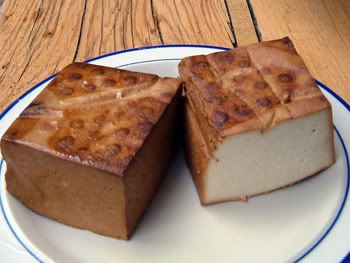
This is home-smoked tofu, but I often use Soya Nova Organic Smoked Tofu from Saltspring Island here in BC; or Pete's Soyganic Organic Smoked Tofu (from Vancouver).
UPDATE (October 24, 2008): I posted on how to make your own smoked tofu here!
Sorry I haven't blogged for so long! There was a combination of out-of-town company (here for my mother's 90th birthday), two close relatives having to go into hospital for emergencies (everyone will be fine, thank goodness), and, sigh....storm season is here again. We had a wind storm Saturday night. It didn't cause the same damage as last year's big wind storm, but we had no power from Sunday morning until Wednesday night.
This time the thunder was positively biblical and the rain came down in buckets! (At least we could collect lots of water to last us until the power went on again-- we have a pump.)
This kind of weather brings out the cravings for comfort food-- and one-pot comfort food at that, as we had to cook on a one-burner butane stove. The recipe below was one that I developed for an early issue of my vegan Feast Newsletter, when I had a craving for a childhood favorite.
If you haven't tried smoked tofu, you should! It is very firm, smooth and tasty. You can eat it plain, or on crackers, or in a sandwich (especially good with vegan mayo and plum chutney!). It adds a smokey flavor that you would get from bacon, ham, or smoked fish or cheese, so use accordingly. There are a few brands available (this info was updated Oct 1, 2011):
Soya Nova Tofu Shop
1200 Beddis Rd., Ganges, Salt Spring Island, BC, V8K 2C8
(250) 537-9651 soyanova@shaw.ca
Wildwood Foods makes three kinds of smoked tofu.
Tofu Shop in California makes smoked tofu. Store locator.
Soyboy is from NY and is evidently sold US nationwide-- "Our products are available at natural or health food stores, co-ops, or the natural food section of supermarkets."
In Toronto, check out http://www.yingyingsoyfood.ca/products.html#ts
Taifun Organic Smoked Tofu is available online in the UK.
Blue Lotus Smoked Tofu is available in Australia
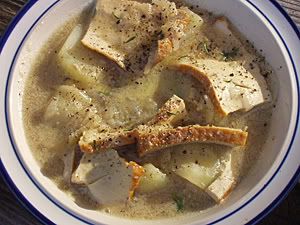
Vegan "Finnan Haddie" made with smoked tofu instead of smoked haddock! (It's a milky, potato-ey Scottish stew, and the recipe will be in a new book coming out at the end of 2010. UPDATE: Recipe here!)
Enjoy, and stay warm and dry!

Labels:
smoked tofu,
tofu,
vegan Finnan Haddie
Tuesday, November 6, 2007
CRANBERRIES, AND A SHORT RANT


Allow me a short rant....
It amazes me that people will pay up to $50 a bottle for some exotic-sounding tropical juice that is supposed to be loaded with vitamin C and antioxidants (and, incidentally, cure everything that ails you!), when they can go to their local grocery store or natural foods market and buy some locally-grown fruits and berries that are every bit as good for you! Or, they can even go pick wild berries for free!
The three tropical fruits that immediately come to mind (and that some companies are getting VERY rich on) are goji berry, noni, and mangosteen. The newest one on the market is acai berry from Brazil. Now, there's nothing wrong with these fruits. They are perfectly good. But why should you pay $40-50 a bottle for the juice (often sold via a multi-level marketing [pyramid] company), when it's no better than any bottled apple juice that you can buy, and certainly less healthful than local fresh fruit or homemade juice? These fruits are no doubt purchased dirt-cheap from Third World countries (Tibet, or, more likely, China, for the goji berries: Tahiti for the noni; and Southeast Asia for the mangosteen). They are then processed into juice (thereby eliminating the fiber, and using a heating process to preserve them for bottling, eliminating alot of the vitamin C and other heat-sensitive nutrients. (Click on the links in this paragraph for more info.)
So, the farmers or pickers in those Third World countries are getting ripped-off, and you are getting ripped-off by paying so much for a bottle of this stuff! The truth is that we have fruits and berries in North America that have just as many (if not more) nutrients and antioxidants as those tropical fruits! Whatever happened to "buy locally"? You can even pick many berries for free in the summer and fall and freeze, can or dry them for winter use, keeping the money in your pocket and treating yourself to some good eating as well as plentiful nutrition.
Here's an article about the new, CHEAP "super-fruit" that's been hiding in the hedgerows of Europe and North America-- black currants! (Remember Ribena?)
If you read the article at the bottom of this blog post that I wrote on antioxidants, you will see a list of the 20 foods with the highest antioxidant activity. You will notice that they are all grown in North America!
One of my favorites on that list is cranberries, which are grown in BC and many other areas in North America, and which is a cousin of the blueberry (high up on said list). You can read about the many health benefits of the cranberry here. The season for cranberry delights is coming upon us, but they are good all year round, and they are widely available, fresh, frozen, and dried (look for the UNsweetened dried ones).
So, what if you don't go for the juice, but go for the fruit or the dried fruit of these tropical fruits? Well, as far as I know, noni is not available in North American markets, and maybe just as well. Here's how the Wikipedia entry for noni fruit describes it:
"The fruit is a multiple fruit that has a pungent odor when ripening, and is hence also known as cheese fruit or even vomit fruit." It eveidently tastes so bad that it has to be cut with other fruit juices.
You can sometimes find mangosteens in markets in large cities, but, again, what about eating locally? Goji berries are generally sold dried. So why not just eat fresh North American fruits that are high in antioxidants, and dried North American fruits and berries? Dried goji berries cost from $19.95-$39.95/18 oz. online. It is not always clear whether they are organic or not, and how could you tell anyway, when they come from China? Organic dried unsweetened cranberries, on the other hand can be had for $14.25/18 oz. (tierrafarm.com), and organic dried blueberries for $14.92/18 oz. (traversebayfarms.com). Or, you could buy or pick wild or organic blueberries in the summer and dry them yourself!
Here is some info about the hype around goji berry, noni, and mangosteen juice (some are sold by companies that use pyramid schemes). I couldn't find anything on acai berry juice that wasn't from a company or website trying to sell it or get you to sell it!
Here's a Nutrition Action Newsletter pdf file article "Squeezing cash out of three 'hot' juices". (One of the juices is pomegranate, but it's quite a bit cheaper than the others [about $10 a bottle], and at least it tastes good, and can be grown in some areas of North America. Here is an article by Ralph Moss, Phd, from cancerdecisions.com, about the health benefits of pomegranate, and a warning.)
Another short article about the above. Here's a quote: "Salespeople for Tahitian Noni juice were caught on camera by a CBS affiliate in Los Angeles, claiming that the tropical juice “does miracles” for lupus, dementia, and macular degeneration, a leading cause of blindness among older Americans. But no good studies have shown that noni, a lime green fruit found in tropical Asia and islands in the Pacific, has any unique benefits. A distributor was also recorded telling new recruits that the juice tastes “just like money.” No kidding—a 32-ounce bottle of Tahitian Noni juice runs $42."
The CBC program "Marketplace" featured a piece on the goji berry juice scam: watch the whole show here .
On Noni juice by Ralph Moss, PhD of The Moss Reports (Alternative cancer Treatments)
Is there more about mangosteen juice, or Xango, one name that it's sold under? Here's another article. And here's the last bit of that article:
"Some Anti-Oxidant Rich Foods: Cheap Alternatives
Okay, now that I feel a little better to have expressed my truth about this mangosteen juice, let me give you some quick tips that these companies certainly don’t want you to know.
1- Berries — Berries are by far the one of the richest sources of antioxidants, particularly wild blueberry. I suggest having as many berries as you can. Plus they are particularly enjoyable to eat. When wild blueberries are in season, freeze them in ridiculous quantities and use them throughout the year.
2- Pomegranate Juice — Pomegranate Juice is a very high source of cancer-fighting anti-oxidants. You can either purchase fresh pomegranates and make the juice yourself, or purchase pomegranate concentrate (which is still a high source of anti-oxidants). The good thing is that even a big jug of pomegranate juice will only cost you about $7, so 5 times less than the mangosteen juice (which is made mostly with other juices). And best of all, you can find it in most health food stores.
3- Prunes — According to recent studies, prunes rank really high on the “anti-oxidant” score. Good thing, because they are also very delicious.
4- Greens — Dark green leafy vegetables are also an excellent source of anti-oxidants. But not just that. Greens contain more nutrition than any other foods!
5- Mangosteen — Finally, you can also get the health benefits of mangosteen… by trying them out fresh. They are very delicious. You can find them in many Asian markets. Even at $5 a pound, you’re still going to get a better deal than you would get on the Xango juice. And if you ever travel to Costa Rica in September, or Asia in the winter, you’ll get all of the mangosteens you can eat, at dirt cheap prices."

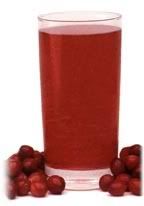
Unsweetened dried cranberries and cranberry juice-- other ways to enjoy cranberries
ANTIOXIDANT POWER!
by Bryanna Clark Grogan
First published in The Island Word from Courtenay, BC, and then in my Vegan Feast subscription newsletter.
I was once teaching a cooking class and meantioned the power of antioxidants to protect us from ‘free radicals”. One woman quipped, “I married one of those, and he’s not free or radical anymore!”
But, to get serious, “Free radicals”, in the case of our bodies’ internal workings, are like gangs of vandals in your body. These molecules are released when oxygen is burned along with fuel for energy in your body (so free radical production is as natural as breathing). Free radicals have at least one extra electron, which gives them a negative charge and drives them through your body, scavenging for cells with which they can react. These reactions can damage DNA and other substances in your cells. Your body’s natural defense system, ideally, should be able to cope with this. But environmental assaults on the body, such as ultraviolet radiation, tobacco smoke, the wrong kinds of fats, alcohol, injury, over-strenuous exercise, chronic disease, and environmental pollution, can overpower the body's ability to neutralize free radicals, allowing them to cause damage to the structure and function of the body's cells.
That’s where antioxidants come in.
Antioxidants are the most widely known of the phytochemicals. These antioxidant molecules exist as vitamins, minerals and other compounds, and they have a positive charge, so they can neutralize the free radicals. When you are young, your cells usually have the capacity to repair much of the damage themselves, but, as you age, the body’s ability to repair itself diminishes (sigh). So, as you age, you need more antioxidants to prevent and repair the free radical damage.
Heart disease, Alzheimer’s, cancer, autoimmune diseases, degenerative retinal damage, and stroke are only a few of the conditions which are now thought to be related to free radical damage in some way.
We shouldn't take an antioxidant pill (not there aren’t people out there trying to sell them to you!) because we haven’t even identified them all yet (it is estimated that there are about 4000)! The most studied antioxidants include vitamins C and E, betacarotene and the mineral selenium. You CAN take pills for these particular antioxidants, but recent studies are showing that—surprise, surprise!-- they are more efficacious when taken in food. And a whole lot tastier, too. So, do like the healthiest and longest-lived people in the world, the Okinawans, and eat 10 fruits and vegetables every day!
In a recent USDA study, the antioxidant levels in over 100 different foods were analyzed. Fifteen out of the top 20 ranked foods that help protect cells from the damage caused by "free radicals" are fruits or veggies. Several dried beans ranked high, as well.
The Top 20 antioxidant foods, according to a USDA ranking by antioxidant value per serving size: (notice that ALL of these foods are grown in North America and are relatively inexpensive-- some can even be picked wild)
1.) Small red beans (dried)
2.) Wild blueberries (some people say that these are #1, but every list I’ve seen list them #2)
3.) Red Kidney beans
4.) Pinto beans
5.) Blueberries (cultivated)
6.) Cranberries
7.) Artichokes (cooked)
8.) Blackberries
9.) Prunes
10.) Raspberries
11.) Strawberries
12.) Red Delicious apples
13.) Granny Smith apples.
14.) Pecans
15.) Sweet cherries
16.) Black plums
17.) Russet potatoes (cooked)
18.) Black beans (dried)
19.) Plums
20.) Gala apples
ADDENDUM:
From “Becoming Vegan” by Vesanto Melina, RD and Brenda Davis,RD, p.148)
“Cooking can alter the structure of phytochemicals, resulting in very different health effects. In some cases cooking increases the availability of phytochemicals, while in others it is reduced. For example, lycopene is better absorbed from the cooked tomatoes than from raw tomatoes. Cooking can also change phytochemicals, giving them entirely different properties. For example, when garlic is cooked in water, vinyldithiins are produced; when cooked in oil, ajoenes are formed. It looks as though we are best to include a variety of both raw and cooked foods in the diet.”
Here are some recipes on this utilizing these foods, but be sure to check the Recipe Links page for more berry, pomegranate and plum recipes, and recipes using pecans, beans, artichokes, and potatoes. There's a list of apple recipes here.
Enjoy!

Labels:
acai,
antioxidants,
cranberries,
cranberry,
goji berry,
mangosteen,
noni,
pomegranate,
Ralph Moss,
tofu
Subscribe to:
Comments (Atom)
